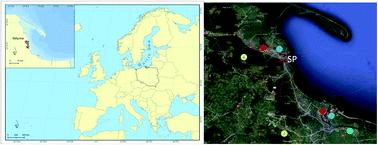当前位置:
X-MOL 学术
›
Environ. Sci.: Processes Impacts
›
论文详情
Our official English website, www.x-mol.net, welcomes your
feedback! (Note: you will need to create a separate account there.)
Seasonal variability of trace elements in fine particulate matter (PM2.5) in a coastal city of northern Poland – profile analysis and source identification
Environmental Science: Processes & Impacts ( IF 4.3 ) Pub Date : 2020-05-19 , DOI: 10.1039/d0em00031k Patrycja Siudek 1, 2, 3
Environmental Science: Processes & Impacts ( IF 4.3 ) Pub Date : 2020-05-19 , DOI: 10.1039/d0em00031k Patrycja Siudek 1, 2, 3
Affiliation

|
A large group of trace elements (Al, As, Cd, Co, Cr, Cu, Fe, Mn, Mo, Ni, Pb, Ti, V, and Zn) was measured for the first time in 226 air samples collected at a coastal monitoring station in Gdynia (northern Poland), in the period from January 12th to August 30th, 2019. The 24 h measurements included fine particle (PM2.5) concentrations, meteorological parameters and backward air mass trajectory analyses. The monthly mean PM2.5 mass concentration ranged from 17.3 μg m−3 to 55.0 μg m−3, and the peak value of 167 μg m−3 was found in February. Overall, considerable differences in the trace element concentrations were observed. However, their seasonal distributions were not similar. In particular, elements such as Cd, Cu, Mo, Ni, V and Zn showed significantly higher concentrations (p < 0.05) in winter compared to spring or summer. The winter peak of trace element concentrations in PM2.5 indicated that local power plants and fossil fuel/coal combustion in the residential sector were the major anthropogenic sources of air pollutants. Based on multivariate analysis (PCA) of the standardized database (14 elements and PM2.5), a significant contribution of different sources and processes was identified, i.e. local traffic emission, local/regional coal/oil burning in power plants and domestic heating units, industrial activities, petrochemical industry and maritime transport. The Cu/Fe ratios revealed that both local traffic and brake-wear emission considerably influenced the chemical composition of PM2.5. In addition, the results of the V/Ni ratio suggested local mixed industrial sources (petrochemical refinery and industrial plants) with possible contributions from the port area and shipping activities to the total PM2.5 loadings. The local ship emission was more pronounced during the summer period.
中文翻译:

波兰北部沿海城市中细颗粒物(PM2.5)中微量元素的季节性变化–剖面分析和来源识别
首次在沿海地区收集的226个空气样品中首次测量了大量痕量元素(Al,As,Cd,Co,Cr,Cu,Fe,Mn,Mo,Ni,Pb,Ti,V和Zn)格丁尼亚(波兰北部)的监测站,时间为2019年1月12日至8月30日。24小时的测量包括细颗粒(PM 2.5)浓度,气象参数和后向空气质量轨迹分析。PM 2.5的月平均质量浓度范围为17.3μgm -3到55.0μgm -3,峰值为167μgm -3被发现于二月。总体而言,观察到痕量元素浓度的显着差异。但是,它们的季节性分布并不相似。尤其是,与春季或夏季相比,冬季的Cd,Cu,Mo,Ni,V和Zn等元素显示出明显更高的浓度(p <0.05)。冬季PM 2.5中微量元素浓度的峰值表明,居民区的当地发电厂和化石燃料/煤燃烧是人为污染空气的主要来源。基于标准化数据库(14个元素和PM 2.5)的多元分析(PCA),确定了不同来源和流程的重要贡献,即本地交通排放,发电厂和家庭供热装置的本地/区域煤/油燃烧,工业活动,石化工业和海上运输。铜/铁比表明,局部交通和制动磨损排放都极大地影响了PM 2.5的化学成分。此外,V / Ni比的结果表明,当地混合的工业来源(石化炼油厂和工厂)可能与港口地区和航运活动对PM 2.5总装载量的贡献有关。在夏季,当地船只的排放更为明显。
更新日期:2020-05-19
中文翻译:

波兰北部沿海城市中细颗粒物(PM2.5)中微量元素的季节性变化–剖面分析和来源识别
首次在沿海地区收集的226个空气样品中首次测量了大量痕量元素(Al,As,Cd,Co,Cr,Cu,Fe,Mn,Mo,Ni,Pb,Ti,V和Zn)格丁尼亚(波兰北部)的监测站,时间为2019年1月12日至8月30日。24小时的测量包括细颗粒(PM 2.5)浓度,气象参数和后向空气质量轨迹分析。PM 2.5的月平均质量浓度范围为17.3μgm -3到55.0μgm -3,峰值为167μgm -3被发现于二月。总体而言,观察到痕量元素浓度的显着差异。但是,它们的季节性分布并不相似。尤其是,与春季或夏季相比,冬季的Cd,Cu,Mo,Ni,V和Zn等元素显示出明显更高的浓度(p <0.05)。冬季PM 2.5中微量元素浓度的峰值表明,居民区的当地发电厂和化石燃料/煤燃烧是人为污染空气的主要来源。基于标准化数据库(14个元素和PM 2.5)的多元分析(PCA),确定了不同来源和流程的重要贡献,即本地交通排放,发电厂和家庭供热装置的本地/区域煤/油燃烧,工业活动,石化工业和海上运输。铜/铁比表明,局部交通和制动磨损排放都极大地影响了PM 2.5的化学成分。此外,V / Ni比的结果表明,当地混合的工业来源(石化炼油厂和工厂)可能与港口地区和航运活动对PM 2.5总装载量的贡献有关。在夏季,当地船只的排放更为明显。











































 京公网安备 11010802027423号
京公网安备 11010802027423号